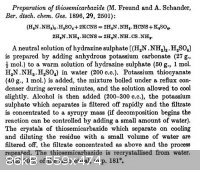benzylchloride1
Hazard to Others
  
Posts: 299
Registered: 16-3-2007
Member Is Offline
Mood: Pushing the envelope of synthetic chemistry in one's basement
|
|
Thiosemicarbazide Synthesis
Thiosemicarbazide can be synthesized via an easy high yielding procedure from hydrazine sulfate and ammonium thiocyanate. Warning thiosemicarbazide is
extremely toxic and the upmost care must be taken when handling this reagent. Thiosemicarbazide is useful for synthesizing a varity of heterocycles
such as 1,2,4 triazole which is a useful peptide coupling reagent. I recently synthesized thiosemicarbazide via a procedure modified for amateur use
from Weygand and Hilgetags Preparative Organic Chemistry see page 410 for the full scale procedure using hydrazine hydrate.
Experimental:
Hydrazine sulfate was prepared via Roscoe Bodines Method.
Ammonium Thiocyanate was purchased off the internet
This reaction must be conducted in a hood because hydrogen sulfide is produced during the refluxing.
36.7 g of hydrazine sulfate was added to 30 ml of water in a 250ml flask. The pH of the solution was then adjusted to 4 with a sodium hydroxide
solution using a pH meter. The hydrazine sulfate soon dissolved due to the formation of hydrazinium hydrogen sulfate. 30g of ammonium thiocyanate was
added and the mixture was swirrled in a warm water bath until the thiocyanate dissolved and for a further 10 minutes. 60 ml of methanol was added and
the mixture was stirred for 30 minutes to finish the precipitation of ammonium sulfate. The solution was filtered and the ammonium sulfate was washed
with methanol. The combined liquid was then transferred to a 500 ml round bottomed flask. A stirr bar was added and 1 ml of acetone was added. A
reflux condenser was attached and the mixture was refluxed for 18 hours. The solution turns to a yellow color during refluxing and produces hydrogen
sulfide; after 9 hours another 1 ml of acetone was added. After 18 hours the mixture was filtered to remove a small amount of crystalline material.
After cooling overnight, a large crop of crystals formed which was then filtered off and washed with methanol. The white colored crystals melted at
180 Celsius, which is in the range of the literature value of 180-183 Celsius. The first crop of crystals weighed around 11 grams. The filtrate is
being cocentrated to obtain more crops of crystals. The yield will be reported once all of the crops of crystals have been combined.
[Edited on 1-11-2009 by benzylchloride1]
[Edited on 1-11-2009 by benzylchloride1]
[Edited on 1-11-2009 by benzylchloride1]
Amateur NMR spectroscopist
|
|
|
entropy51
Gone, but not forgotten
    
Posts: 1612
Registered: 30-5-2009
Member Is Offline
Mood: Fissile
|
|
A nice prep, benzylchloride1. Not relevant to your method, but to the thread topic, I've had occaision to make substituted thiosemicarbazides by
reacting isothiocyanates and hydrazine. The reaction goes very nicely in isopropanol and the yield is often close to theory.
|
|
|
benzylchloride1
Hazard to Others
  
Posts: 299
Registered: 16-3-2007
Member Is Offline
Mood: Pushing the envelope of synthetic chemistry in one's basement
|
|
Here is the final yield after obtaining all the crops of crystals, the last crop of crystals was boiled with methanol to remove a yellow colored
impurity. 19.1g of product was obtained. The theoretical yield is 25.7g, for a percentage yield of 74%. The procedure claims over 90%, more could
probably have been obtained on further concentration. Now to make some 1,2,4-triazole once my formic acid arrives
Amateur NMR spectroscopist
|
|
|
Klute
International Hazard
    
Posts: 1378
Registered: 18-10-2006
Location: France
Member Is Offline
Mood: No Mood
|
|
Nice prep! Heterocyclic chemistry is too rare on this forum!
What's the pupose of the acetone? Initiate the reaction? How does it work?
\"You can battle with a demon, you can embrace a demon; what the hell can you do with a fucking spiritual computer?\"
-Alice Parr
|
|
|
benzylchloride1
Hazard to Others
  
Posts: 299
Registered: 16-3-2007
Member Is Offline
Mood: Pushing the envelope of synthetic chemistry in one's basement
|
|
I would presume that the acetone would react with the thiosemicarbazide to produce acetone thiosemicarbazide, the procedure does not state the reason
for adding the acetone, but I would assume that it acts as a catalyst. I obtained some formic acid, so I will be synthesizing the 1,2,4-triazole soon.
What would be the best way of running an infrared spectrum of this product? I just got one of my infrared spectrophotometers to work and I would like
to obtain a spectrum of the product. I dont have a KBr press, so I am thinking of using a liquid cell, but I need to determine what solvent to use.
Amateur NMR spectroscopist
|
|
|
mario840
Hazard to Others
  
Posts: 229
Registered: 20-1-2010
Member Is Offline
Mood: No Mood
|
|
look at this, easy synth, no refluxing for such a long time, use cheaper KCNS and yield also fantastic (these from Characterization of Organic
Compounds by F. Wild) :

|
|
|